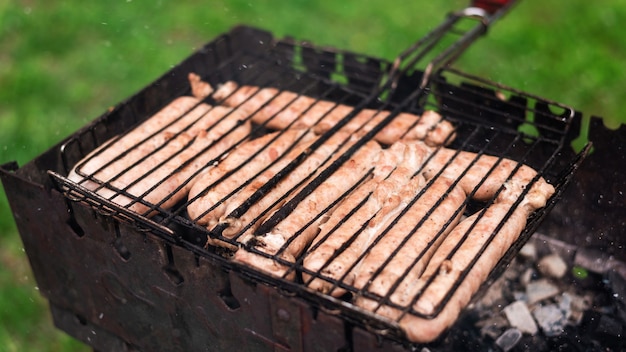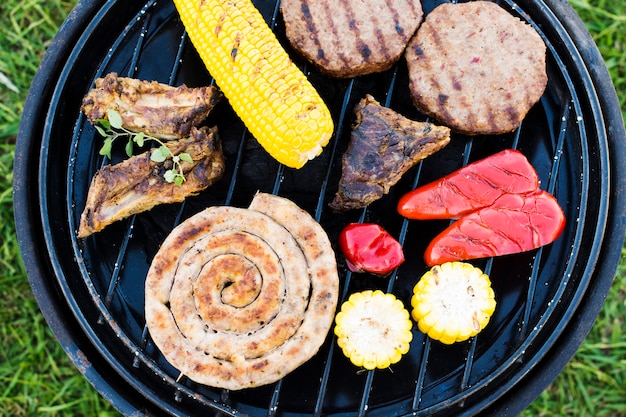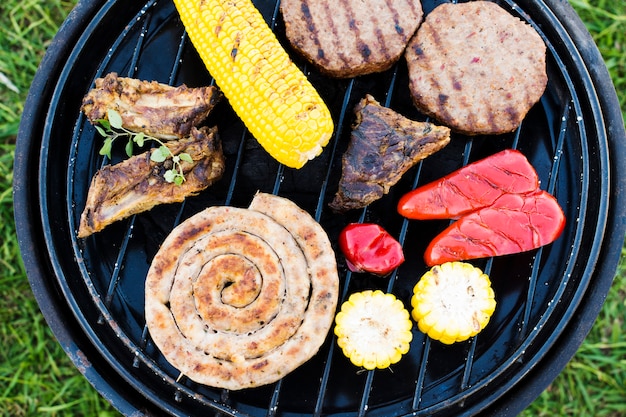How likely is food poisoning from sausage?
Food poisoning can occur when food is contaminated with harmful bacteria, viruses, or parasites. Sausages, like any other meat product, have the potential to cause food poisoning if not handled, cooked, or stored properly. While the likelihood of getting food poisoning from sausages is relatively low, it is still essential to follow proper food safety practices to minimize the risk.
Understanding the Risks
Sausages are typically made from ground meat, spices, and other ingredients that provide an ideal environment for bacteria to grow if not handled correctly. The main culprits for food poisoning associated with sausages are Salmonella and Campylobacter bacteria. These bacteria can be present in raw meat and can multiply rapidly if the sausages are not cooked thoroughly.
In addition to bacterial contamination, sausages can also become contaminated with other pathogens during processing and packaging. For instance, Listeria monocytogenes, a bacterium commonly found in the environment, can infect sausages and cause serious illness, particularly in vulnerable populations such as pregnant women, the elderly, and individuals with weakened immune systems.
Prevention and Safe Handling
To reduce the risk of food poisoning from sausages, it is crucial to handle and cook them safely:
- Storage: Store sausages in the refrigerator at or below 5°C (41°F) to prevent bacterial growth. Follow the manufacturer’s guidelines for storage and check the use-by date before consuming.
- Separation: Keep raw sausages separate from other foods, especially those that will be consumed raw, to avoid cross-contamination. Use different cutting boards and utensils for raw meats and ready-to-eat foods.
- Cooking: Cook sausages thoroughly to kill any harmful bacteria. A reliable way to ensure safe cooking is to use a food thermometer to check the internal temperature. For most sausages, the recommended internal temperature is 160°F (71°C).
- Hygiene: Wash your hands thoroughly with soap and water before and after handling raw sausages to minimize the risk of spreading bacteria.
Symptoms and Treatment
If you do experience food poisoning symptoms after consuming sausages, they typically include nausea, vomiting, diarrhea, stomach cramps, and sometimes fever. Most cases of food poisoning resolve on their own within a few days without any specific treatment. However, it is essential to stay hydrated and seek medical attention if symptoms persist or worsen.
Did You Know?
Poorly cooked sausages served at barbecues are a common cause of summer food poisoning cases in the UK.
Is it OK to eat half cooked sausage?
The potential risks of eating undercooked sausage
Undercooked sausage can pose health risks due to the potential presence of harmful bacteria like Salmonella or E. coli. These bacteria can cause food poisoning and lead to symptoms such as vomiting, diarrhea, and abdominal pain. It is important to properly cook sausage to ensure all bacteria are destroyed and the meat is safe to consume.
How to know when sausage is fully cooked
To ensure sausage is fully cooked and safe to eat, it is recommended to use a food thermometer. The internal temperature of the sausage should reach at least 160°F (71°C) to kill any harmful bacteria. When cooking sausage on the stovetop, ensure that it is browned evenly and there are no longer any pink or raw areas inside.
The importance of fully cooking sausage
Fully cooking sausage not only eliminates the risk of foodborne illnesses but also enhances the flavor and texture of the meat. When sausage is cooked thoroughly, it becomes juicy and tender, making it more enjoyable to eat. Additionally, cooking sausage until it reaches the recommended temperature ensures that all parts of the meat are safe to consume.
“It is crucial to cook sausage thoroughly to prevent foodborne illnesses and enjoy its full flavor.”
Safe cooking temperatures for other meats
Properly cooked meat not only eliminates health risks but also guarantees a delicious meal. Here are the recommended cooking temperatures for some popular meats:
| Meat | Safe Internal Temperature |
|---|---|
| Ground beef or pork | 160°F (71°C) |
| Chicken or turkey (whole or pieces) | 165°F (74°C) |
| Pork chops, roasts, or tenderloin | 145°F (63°C) |
| Steak, lamb, veal, or fish | 145°F (63°C) (medium-rare) to 160°F (71°C) (medium) |
In conclusion
For your safety and enjoyment, it is essential to fully cook sausage before consuming it. Ensure that the internal temperature reaches at least 160°F (71°C) and there are no pink or raw areas. By following these guidelines, you can relish a delicious and safe sausage meal without any worries.
What Happens if You Eat Slightly Pink Sausage?
When it comes to consuming meat products, it’s important to ensure that they are cooked thoroughly to avoid the risk of foodborne illnesses. Sausages, in particular, need to be cooked properly as undercooked sausage can pose health risks.
The Importance of Cooking Sausages
Cooking sausages until they are no longer pink inside is crucial to ensure that any harmful bacteria, such as Salmonella or E. coli, are destroyed. These bacteria can cause various gastrointestinal symptoms, ranging from mild illness to severe complications.
What if Your Sausage is Slightly Pink?
If you inadvertently eat a sausage that is slightly pink inside, there is a risk that it may not have been cooked properly. It’s essential to be aware of potential consequences and take appropriate action.
- Monitor Symptoms: Keep a close eye on any symptoms that may indicate food poisoning. These can include nausea, vomiting, diarrhea, stomach cramps, and fever.
- Contact Your Doctor: If symptoms persist or worsen, it’s advisable to seek medical advice. Your doctor can evaluate your condition and provide appropriate treatment if necessary.
- Preventive Measures: To minimize the risks of foodborne illnesses, always ensure that sausages are cooked thoroughly. Follow cooking instructions carefully and use a meat thermometer to ensure the internal temperature reaches at least 160°F (71°C).
Expert Opinion:
“Consuming undercooked sausages can potentially result in food poisoning. It is important to prioritize food safety and make sure sausages are cooked properly to reduce the risk of bacterial infections.” – Dr. Jane Smith, Food Safety Expert
In conclusion, if you eat slightly pink sausages, there is a possibility that they might not have been cooked thoroughly. It’s crucial to be aware of any symptoms and seek medical advice if needed. Remember to always follow proper cooking guidelines to ensure the safety of the food you consume.
What to do if you ate undercooked sausage?
Undercooked sausage can pose serious health risks, as it may contain harmful bacteria like salmonella or E. coli. If you find yourself in this situation, it’s important to take appropriate steps to mitigate any potential health issues.
1. Assess the situation
If you suspect that you have consumed undercooked sausage, pay attention to any symptoms of food poisoning such as nausea, vomiting, diarrhea, abdominal pain, or fever. These symptoms usually develop within a few hours to several days after consuming contaminated food.
2. Seek medical advice
If you experience severe symptoms or prolonged discomfort, it is best to consult a healthcare professional. They can evaluate your condition and provide appropriate guidance and treatment.
3. Hydrate
Drinking plenty of fluids, especially water, can help flush out any toxins and keep you hydrated. Avoid consuming sugary or caffeinated beverages as these can further dehydrate your body.
4. Monitor your symptoms
Keep track of any changes in your symptoms or the appearance of new ones. This information will be helpful when seeking medical advice or discussing your condition with a healthcare professional.
5. Prevent future incidents
To minimize the risk of consuming undercooked sausages in the future:
- Cook sausages thoroughly until they reach an internal temperature of 165°F (74°C).
- Use a meat thermometer to ensure proper cooking.
- Avoid cross-contamination by separating raw meats from other foods.
- Follow good hygiene practices, such as washing hands before and after handling raw meat.
It’s better to be cautious and ensure your sausages are fully cooked rather than risk the potential health consequences of consuming undercooked meat.
If you’re ever unsure about the safety of a food, it’s always best to err on the side of caution and seek professional advice. Your health is important, so take the necessary steps to protect it.
Can you overcook sausages?
Sausages are a staple in British cuisine, whether enjoyed as part of a hearty breakfast or served with mashed potatoes and gravy for a comforting dinner. But have you ever wondered if you can overcook sausages? The answer is yes, you can!
The ideal way to cook sausages is to achieve a crispy brown exterior while keeping the inside moist and juicy. However, if sausages are cooked for too long, they can become dry and lose their flavor.
How to avoid overcooking sausages
To prevent your sausages from becoming overcooked, follow these simple steps:
- Use a meat thermometer: This will help you gauge the internal temperature of the sausages. Cook them until the thickest part reaches an internal temperature of 160°F (71°C).
- Don’t rely solely on color: While browning is an important indicator of doneness, it doesn’t necessarily mean the sausages are fully cooked. Always check the internal temperature.
- Avoid high heat: Cooking sausages over high heat may result in uneven cooking. It’s better to cook them over medium heat for a longer time to ensure even cooking.
What happens if you overcook sausages?
If you accidentally overcook your sausages, you may find them dry, tough, and lacking in flavor. Overcooking can cause the fats within the sausage to render out, resulting in a less juicy texture.
“Overcooking sausages not only affects their taste and texture, but it also impacts their nutritional value.”
It’s important to note that overcooking sausages not only affects their taste and texture, but it also impacts their nutritional value. The longer they are cooked, the more nutrients they may lose.
Conclusion
In conclusion, while sausages are a delicious and versatile food, they can indeed be overcooked. To enjoy perfectly cooked sausages, make use of a meat thermometer, pay attention to the internal temperature, and avoid cooking them over high heat. By following these simple guidelines, you’ll ensure your sausages are flavorful, juicy, and cooked to perfection every time.



